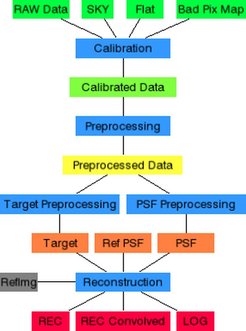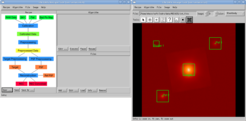Data Reduction Software (for LINC-NIRVANA)
Image Reconstruction Pipeline

The processing steps for the data reduction and the reconstruction are shown as blue rectangles in the flowchart:
- Calibration: compensates for imaging sensor and instrument issues like variations in pixel gain or bad pixels.
- Preprocessing: compensates for observation issues like image rotation or slight positioning mistakes.
- Target Preprocessing: extracts the target from the preprocessed data.
- PSF Preprocessing: extracts/models the PSF (point spread function, brightness distribution of a point source on the imaging sensor) from the preprocessed data.
- Reconstruction: reconstructs the observed object from the target and PSF images.
The Software uses the following files during processing:
- RAW Data: the raw interferograms of the observed target object or the calibrator star.
- SKY: background images of the sky without objects (optional).
- Flat: the flat field map for compensating for the variations in pixel gain.
- Bad Pix Map: the bad pixel map for interpolating bad pixels.
- Calibrated Data: the calibrated individual interferograms (imaging sensor and instrument effects are compensated for).
- Preprocessed data: the preprocessed individual interferograms (observational effects are compensated for).
- Target: the extracted target object prepared for the reconstruction algorithm.
- PSF: the extracted or modeled PSF ready for the reconstruction algorithm.
- Ref PSF: The ideal PSF of a 23 m telescope (optional), necessary for calculating the convolved reconstruction (REC Convolved [red background]).
- REC: the (non-convolved) result of the reconstruction (the resolution is higher than can actually be achieved).
- REC Convolved: the result of the reconstruction convolved with the ideal 23 m PSF. This is consistent with the maximum resolution achievable with LINC-NIRVANA.
Implementation
The LN DRS is implemented in IDL. The software architecture uses an approach, in which the structure of the reduction pipeline and the available algorithms and tools are fully configurable. This means that an experienced user can define and implement new data reduction algorithms. Even new data reduction steps can be inserted into the pipeline. The LN DRS can be used interactively via two main windows.

The (configurable) flowchart in the main window provides access to the available algorithms and files. All parameters for the algorithms, the file names and markers in the images (for example, the target object and the calibrator star to be marked) are specified in a configuration file. The user interface serves primarily to generate and fill these configuration files:
- The files to be used as raw data or calibration data are selected.
- The target object and one or more calibrator stars are to be marked in the raw data.
- The desired algorithms for the individual processing steps are to be selected from the long list of available algorithms.
- Depending on the selected algorithm, the corresponding parameters are to be set according to the use case.
A function of the data reduction software can also help run the preprocessing steps fully automatically. For a detailed description of the graphical user interface and its components, please see the Tutorial.
Distribution
The LINC-NIRVANA data reduction software (LNDRS) source code is available. Also available are a short tutorial and simulated test cases with results. The following components are needed:
- The additional astronomical library idlastro (mandatory).
- The LNDRS packet lndrs (mandatory).
- The tutorial and reference manual (recommended).
- Example data for the tutorial (recommended).
- A test report (optional).
- Test data from the report including configuration data (optional, extensive)

